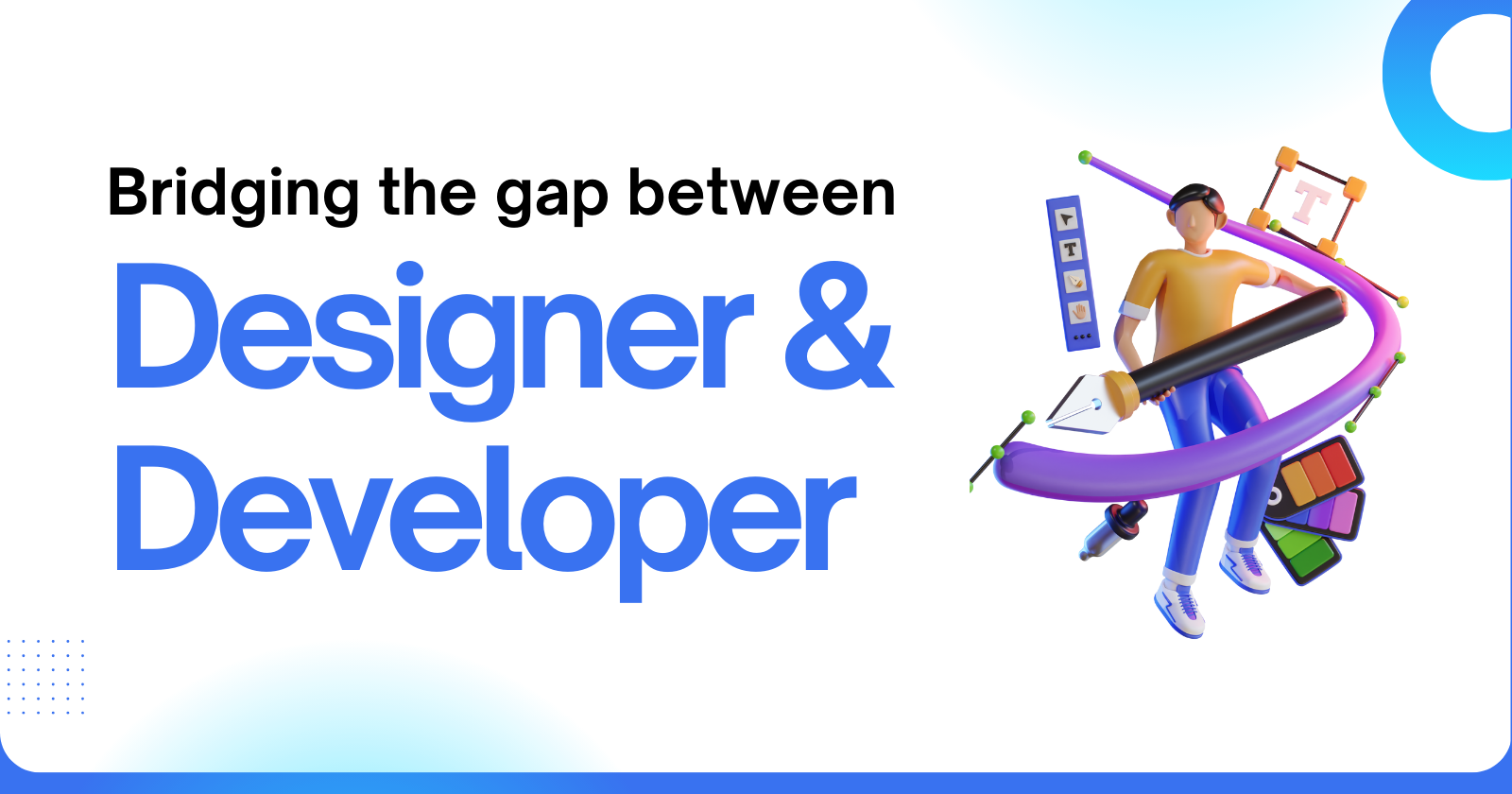Bridging the Gap: How Designers and Developers Can Truly Collaborate
 Abishek Chuhan
Abishek Chuhan
The Age-Old Tug of War
Imagine building a bridge—one team on the left, one on the right, to meet perfectly in the middle. But what happens when one side builds with bricks while the other uses steel? Or when the teams don't communicate until the final moment? Disaster. This mirrors the reality of most designer-developer relationships.
Designers communicate through images, emotions, and aesthetics, while developers focus on logic, functionality, and usability. Though they're creating the same product, they might as well be working on different planets. The result? Frustration, wasted time, and a final product that strays far from its original vision.
But it doesn't have to be this way.
Step 1: Build a Shared Understanding
While designers and developers don't need to master each other's work, they must understand and value how the other thinks—this is the key to effective collaboration.
For Designers: Look beyond pure aesthetics and consider how interactions shape real product experiences. Think about your design's performance, accessibility, and scalability. Remember that a product's success depends on both its appearance and functionality. Consider key questions: How will the design perform across different environments? How well does it adapt to various screen sizes? Can users with disabilities access it effectively?
For Developers: Don't simply focus on making things work—understand how design choices shape the user's journey. Look beyond technical implementation to see the bigger picture. How do micro-interactions, typography, and spacing enhance the overall user experience? In what ways does the design either support or impede user satisfaction and functionality?
A great product isn’t just about looking good or working well—it’s about seamlessly merging both worlds. Designers and developers need to think of themselves as co-architects of the user experience.

Step 2: Kill the "Handoff" Mindset
The traditional "handoff" approach—where designers complete their work before passing it to developers—is outdated and ineffective. Instead, embrace ongoing collaboration from day one. This early partnership enables both teams to make informed decisions that strengthen the final product.
Bring Developers into the Design Process Early
Instead of waiting until the design is complete to involve developers, bring them into the process during the ideation phase. Here’s how you can do that:
Co-Create Wireframes and Prototypes: Involve developers in the early wireframing process, where ideas are still in their infancy. Developers can offer valuable input on feasibility, ensuring that the design is realistic and scalable from the start.
Collaborative Design Sessions: Set up short, focused sessions where both designers and developers can work together to tweak UI elements as the design evolves. This not only reduces confusion but also fosters a sense of shared ownership.
Micro-Check-ins Instead of Formal Reviews: Instead of waiting for formal design reviews, implement quick, informal check-ins throughout the design process. These check-ins can help identify potential issues before they become major roadblocks.
The goal is to make the design and development process iterative, not linear. Both teams should be in sync from start to finish, making continuous improvements rather than handing off finished work for someone else to execute.

Design Iteratively with Feedback Loops
Great collaboration doesn’t happen with one big feedback session at the end of a project—it happens through constant iteration.
Design Prototypes that Developers Can Test: Create interactive prototypes early in the process that developers can play with. This gives them a sense of how the design will feel and lets them provide real-time feedback on functionality, usability, and performance.
Developer-First Annotations: Add clear annotations to your designs to explain behaviors, transitions, and expected outcomes. This will help developers understand the nuances of your designs and how they are meant to function, making it easier for them to implement.
Frequent Sync-ups: Schedule regular, short syncs to discuss progress, challenges, and any necessary adjustments. These informal meetings help both teams stay aligned and adapt as needed, preventing any last-minute surprises.
The more often designers and developers communicate and collaborate, the smoother the process becomes.
Step 3: Replace the Wall with a Window
Most of the time, communication between designers and developers happens through siloed channels—Slack threads, Jira tickets, and emails. These isolated conversations can create barriers and lead to misunderstandings.
To improve this, make everything visible and interactive. Transparency is key to building trust and fostering collaboration.
Join Design Critiques and Code Reviews: Design and development critiques should happen together, not separately. Let designers and developers review each other's work. Designers can give feedback on code implementation, while developers can highlight how design choices affect the product’s functionality.
Live Prototyping: Instead of static wireframes or design files, use interactive prototypes that simulate real user interactions. This allows developers to visualize the final product more clearly and understand the context of each design element.
Shared Workspaces: Utilize collaborative tools like Notion, Miro, or Confluence to document decisions, updates, and guidelines. This keeps both teams on the same page and ensures that all information is accessible to everyone.
Think of it as replacing a brick wall with a glass window—transparency leads to better collaboration and a more cohesive product.

Step 4: Build Empathy Through Role Reversal
Empathy is at the heart of collaboration. If designers and developers truly understand each other’s challenges, they’ll work together more effectively.
One powerful way to build empathy is through role reversal. Take the time to step into each other’s shoes and experience the challenges the other team faces:
Developers: Try designing a basic user interface and have a designer critique it. You'll quickly realize how intricate and delicate design choices can be and how small changes can affect the user experience.
Designers: Attempt to build a simple webpage from scratch. It’s harder than it looks, and it will give you insight into the technical constraints developers face daily.
This exercise isn’t about becoming an expert in the other team’s field—it’s about gaining an understanding and appreciation for their work. Empathy goes a long way in improving communication and collaboration.
Step 5: Align on the "Why" (Not Just the "What")
Designers and developers often focus on the "what"—what features to build, what aesthetic choices to make, and what code to write. But the most important question is "why."
Both designers and developers share the same ultimate goal: delivering an exceptional user experience. While designers focus on creating delightful, intuitive interfaces, and developers prioritize scalable, efficient solutions, the core mission transcends individual team preferences. What matters most is understanding how design and development decisions affect the end user.
Always return to the product’s vision. How does this decision impact the user’s experience? How does this feature align with the product’s goals and objectives? When both teams align on the “why,” it becomes much easier to navigate the “what” and the “how.”
Final Thoughts: Ditch the Divide
At the end of the day, designers and developers aren’t opponents. They are two sides of the same coin. Instead of working in silos or competition, they should view themselves as co-creators, with the same goal in mind: creating an exceptional product that delivers real value to users.
So let’s stop treating collaboration as a challenge to be solved and start seeing it as a superpower to be unlocked. Because when design and development truly work together, the possibilities are endless. Magic happens.
Feel free to share your experiences, thoughts, or any questions you have in the comments. I'm here to help you make the most out of these tools!
Until next time, keep designing with passion and creativity!
Cheers to building beautiful, intuitive digital experiences! 🎨✨
Subscribe to my newsletter
Read articles from Abishek Chuhan directly inside your inbox. Subscribe to the newsletter, and don't miss out.
Written by
